Pentax DA* 50-135mm f/2.8 ED [IF] SDM Review
Pentax DA* 50-135mm f/2.8ED [IF] SDM Performance
At 50mm and maximum aperture, sharpness approaches excellent levels in the centre of the frame, and falls just short of good levels towards the edges of the frame. Stopping down improves performance across the frame with peak levels of clarity being achieved between f/5.6 and f/8. Here sharpness is outstanding in the centre and excellent towards the edges of the frame.Zooming to 70mm results in similar performance at maximum aperture, with very good sharpness being produced in the centre of the frame and fairly good clarity towards the edges. Peak performance is realised at f/8 at this focal length. Here sharpness is outstanding across the frame.
Finally at 135mm, sharpness falls just short of very good levels at maximum aperture and clarity towards the edges of the frame is fair. Stopping down just one stop to f/4 results in outstanding performance in the centre of the frame, but it takes until f/8 until sharpness reaches very good levels towards the edges of the frame.
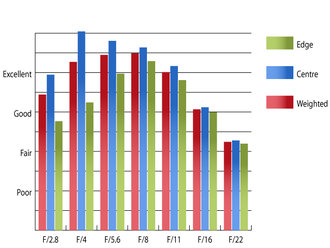 MTF@50mm |
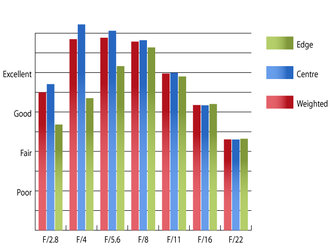 MTF@70mm |
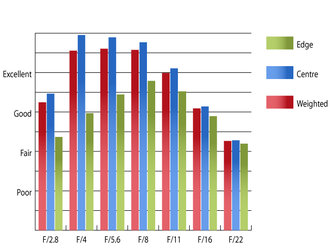 MTF@135mm |
How to read our chartsThe blue column represents readings from the centre of the picture frame at the various apertures and the green is from the edges. Averaging them out gives the red weighted column.The scale on the left side is an indication of actual image resolution. The taller the column, the better the lens performance. Simple. For this review, the lens was tested on a Pentax K-5 IIs using Imatest. |
Chromatic aberrations are well controlled for the most part; remaining well under one pixel width at all settings bar 50mm and f/22. As a result, fringing should rarely be an issue, even in harsh crops from the edges of the frame, or in large prints with high contrast edges.
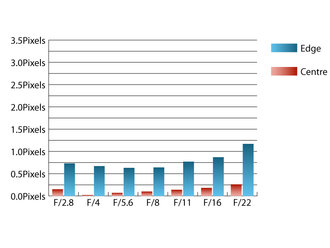 CA@50mm |
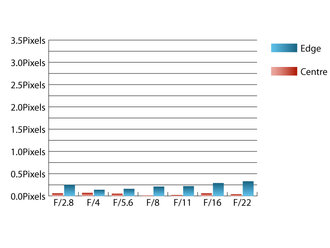 CA@70mm |
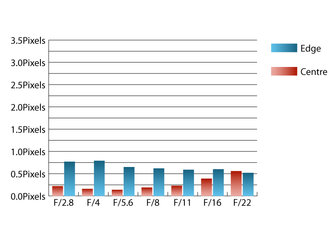 CA@135mm |
How to read our chartsChromatic aberration is the lens' inability to focus on the sensor or film all colours of visible light at the same point. Severe chromatic aberration gives a noticeable fringing or a halo effect around sharp edges within the picture. It can be cured in software.Apochromatic lenses have special lens elements (aspheric, extra-low dispersion etc) to minimize the problem, hence they usually cost more. For this review, the lens was tested on a Pentax K-5 IIs using Imatest. |
Falloff of illumination is well controlled for a lens of this range and maximum aperture. At 50mm the corners of the frame are 0.8 stops darker than the image centre and at 135mm the corners are 1.2 stops darker. Visually uniform illumination is achieved with the lens stopped down to f/5.6 or beyond throughout the zoom range.
Distortion is fairly mild at either end of the zoom range. Imatest detected 0.7% barrel distortion at 50mm, which is replaced by 1.68% pincushion distortion at 135mm. The distortion pattern is uniform across the frame, which should make it relatively easy to apply corrections in image editing software afterwards if straight lines are necessary.
During testing, this lens proved itself resistant to flare and contrast levels are good, even when shooting into the light. The petal-shaped hood does a decent job of shading the lens from extraneous light that may cause issues.
Value For Money
Being priced at around £850, this lens is priced quite reasonably for a manufacturer's own tele-zoom with a constant f/2.8 aperture, especially as there aren't currently any direct equivalents available for Pentax cameras.
Add your message
Login required
Please login here or if you've not registered, you can register here. Registering is safe, quick and free.
Please login here or if you've not registered, you can register here. Registering is safe, quick and free.
photodo Stats
1102 lenses
428 MTF tests
74 in-depth photodo reviews
100+ users join each day
Help the lens community by reviewing or rating a lens today via our lens search
428 MTF tests
74 in-depth photodo reviews
100+ users join each day
Help the lens community by reviewing or rating a lens today via our lens search
Latest Lens Reviews
- Chinon 28mm f/2.8 Vintage Lens Review
- Canon EF 70-200mm f/4L IS II USM Lens Review
- Samyang AF 85mm f/1.4 EF Review
- Sigma 70mm f/2.8 DG Macro Art Review
- Samyang AF 24mm f/2.8 FE Review
- Meike 50mm f/1.7 Review
- Tamron 70-210mm f/4 Di VC USD Review
- Lensbaby Burnside 35mm f/2.8 Review
- Asahi Super Takumar 50mm f/1.4 Review
- Asahi Super-Multi-Coated Takumar 135mm f/3.5 Review
